

 |

|
City of Vancouver Land Use and Development Policies and Guidelines
Community Services, 453 W. 12th Ave Vancouver, BC V5Y 1V4 _ 873.7344 fax 873.7060
[email protected]APPENDIX D
DRAFT
CEDAR COTTAGEMC-1 AND MC-2 GUIDELINES FOR CEDAR COTTAGE, HUDSON STREET, AND EAST HASTINGS (CLARK TO SEMLIN) AREASAdopted by City Council March 24, 1998
AmendedContents
Page
1 Application and Intent 1
2 General Design Considerations 3
2.1/2.2 Neighbourhood/Streetscape Character 3
2.3 Orientation 6
2.4 Views 7
2.6 Light and Ventilation 7
2.7 Weather 7
2.8 Noise 7
2.9 Privacy 8
2.10 Safety and Security 8
2.11 Access and Circulation 93 Uses 9
3.1 Residential Use (Dwelling) 9
3.2 All Residential Buildings (Multiple Dwelling) 10
3.3 Uses at Grade 10
3.4 All Other Conditional Uses 104 Guidelines Pertaining to the Regulations of the Zoning and Development By-law and the Parking By-law 10
4.2 Frontage 10
4.3 Height 11
4.4 Front Yard and Setback 11
4.5 Side Yards and Setbacks 12
4.7 Floor Space Ratio 12
4.9 Off-Street Parking and Loading 13
4.10 Horizontal Angle of Daylight 135 Architectural Components 13
5.1 Roofs 13
5.2 Windows and Skylights 14
5.3 Entrances, Stairs and Porches 15
5.4 Balconies 15
5.5 Exterior Walls and Finishing 15
5.6 Awnings and Canopies 16
5.7 Lights 167 Open Space 17
7.1 Public Open Space 17
7.2 Semi-Private Open Space 17
7.3 Private Open Space 188 Landscaping 18
8.1 Streetscape 18
8.2 Site Landscape 189 Utilities, Sanitation, and Public Services 19
9.2 Underground Wiring 19
9.3 Garbage and Recycling 19Appendix A 20
NOTE: These guidelines are organized under standardized headings. As a consequence, there are gaps in the numbering sequence where no guidelines apply under a standardized heading.
1 Application and Intent
These guidelines are to be used in conjunction with the MC-1 and MC-2 Districts Schedule of the Zoning and Development By-law in the MC-1 areas of Cedar Cottage, Hudson Street and the MC-1 and MC-2 areas of East Hastings (Clark to Semlin).
With respect to Cedar Cottage, these guidelines follow the policy directions of the 1996 MC-1/Welwyn Planning Policies developed for the Cedar Cottage MC-1. The 1996 MC-1/Welwyn Policies also outline proposals for some streetscape improvements along Commercial Street and at key intersections which are to be implemented separately.
With respect to the Hudson Street and East Hastings (Clark to Semlin) Areas, Council approved their rezoning from industrial to MC-1 and MC-2 mixed use on [Date of Enactment].
These guidelines should be consulted in seeking approval for conditional uses or discretionary variations in regulations in the MC-1 and MC-2 areas. As well as assisting the applicant, these guidelines will be used by City staff in the evaluation of projects.
The intent of the guidelines is to:
(a) Achieve compatibility among residential, commercial, and industrial uses in
thisthese mixed use areas; and
(b) Guide building massing and design for neighbourliness, appropriate scale and pedestrian interest.
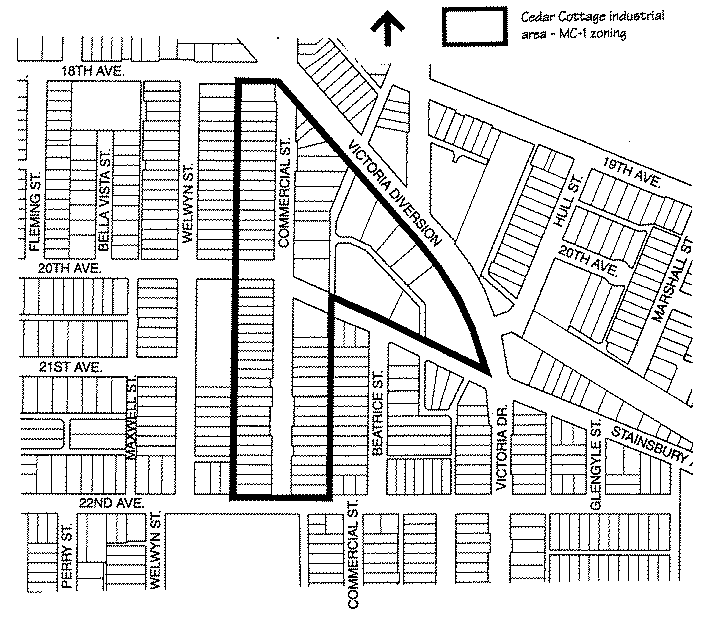
2 General Design Considerations
2.1/2.2 Neighbourhood/Streetscape Character
Existing Character
The Cedar Cottage Area
The Cedar CottageMC-1Aarea has a mix of small and large industrial, service, office and residential uses, with a small amount of retail. The buildings are generally two to four storeys, continuous, and located right at the front property line. The mixture of old and new, the modest scale, the variety of design and use, the urban feel of the street, and the mature street trees contribute to a valued idiosyncratic character.
The vision for the future of the area, as set out in the 1996 MC-1/Welwyn Planning Policies,includes a continuation of its mixed uses and diverse character, while enhancing livability andpedestrian interest. These guidelines follow these policy directions.The Policies also outline proposals for some streetscape improvements along Commercial Street and at key intersections which are being implemented separately.Typical Early 1900s Building
Mature Linden trees: a key asset
Hudson Street Area
The Hudson Street Area has a mix of industrial, service and cultural and recreational uses with a small amount of office and retail uses within its 2.3 ha area. Most buildings are one to two storeys, continuous, and located at the front property line. An existing residential development is located on the north portion of Hudson Street and abuts Hudson Street Area developments which also front Hudson Street.Typical Hudson Street Area Building
Hudson Street Area Streetscape
East Hastings (Clark to Semlin) Area
The East Hastings (Clark to Semlin) Area has a mix of industrial and non-industrial uses. Manufacturing and wholesaling uses are varied and include garment, metal products, kitchen, mattress and food. Retail and Service uses include several auto dealerships and repair, Canadian Tire and Value Village outlets, the Waldorf Hotel and the Memorial Gardens Funeral Home. Along Hastings Street, development is discontinuous with changing character along its length and no clear pattern of similarity in form, scale and massing. Several large sites are extensively paved or vacant, while some segments are more intensely developed where buildings are continuous, two to three storeys, and built to the front property line.Typical Hastings Street (Clark to
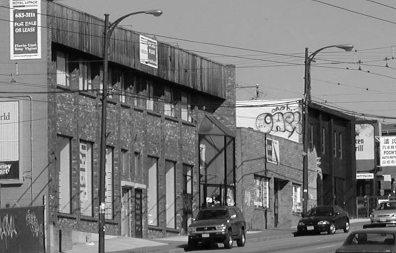
Semlin) Area BuildingHastings Street (Clark to Semlin)
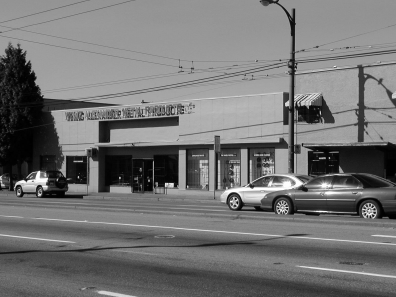
Area StreetscapeCharacter Objectives
The existing pattern of development in the three areas varies, and future development may also have a wide range of uses. In all three areas, these guidelines aim to ensure livability, neighbourliness, compatibility of uses and building massing, quality design and materials, and an attractive street-level treatment.
There are also differences among the areas. In Cedar Cottage, the traditional older buildings with bay windows are the inspiration for guidelines on massing and streetscape treatment. In Hudson Street, the buildings have no traditional character but there is a typical frontage scale and street wall. The guidelines aim to continue the frontage scale and streetwall where possible, while recognizing that all-residential buildings may occur, and will have setbacks. In both these areas, it is anticipated that most new development will be multi-storey, full lot development.
The existing character of Hastings Street is different from the other two areas, and much more diverse. With larger lot assemblies, and a major arterial location, a much wider range of development may occur, from low intensity auto sales and service, to fully developed mixed use. A variety of building scales and placements may occur. The guidelines aim to ensure as much compatibility of siting and massing between neighbouring developments as is reasonable, given their possibly diverse nature; as well as to ensure attractive, quality building design, materials and landscaping.
2.3 Orientation
Cedar Cottage MC-1
The Cedar CottageMC-1Aarea has an established pattern of building faces aligning with streets, which are unusual in layout-orthogonal, curved and angled. The Hudson Street and East Hastings (Clark to Semlin) Areas have an established orthogonal alignment of building face to the street grid.(a) Building faces should be aligned to respect the established street orientations;
(b) On corner sites, both street-facing facades should be fully developed as front elevations; and
(c) In the Cedar Cottage Area, Ddevelopmentonat the southeast corner of Commercial Street and Victoria Diversion should respond to this key intersection with some form of landmark or focal element to "announce" the presence of the area to passers-by.
This.....
Not this......
Landmark opportunity at
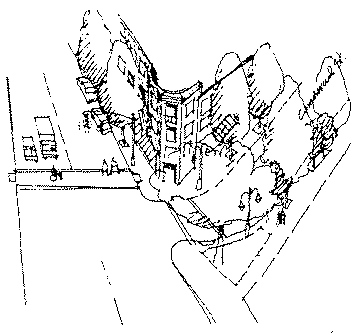
Commercial and Victoria2.4 Views
(a) Existing views enjoyed by adjacent developments should not be unduly compromised by incompatible siting, massing or orientation; and
(b) Opportunities for near views of gardens and landscaped areas should be provided for residents.2.6 Light and Ventilation
Provision of sufficient daylight access to individual units and open spaces is one of the most challenging aspects in the design of residential units in low rise housing. The horizontal angle of daylight
guidelinesregulations in section 4.10 of the Districts Schedule should be supplemented with the following considerations:(a) Living rooms should not face into courtyards;
(b) Below grade residential units often have inadequate daylight, and are generally discouraged;
(c) In double-fronting units (i.e., street/courtyard or lane/courtyard), a minimum clear courtyard dimension of 6.0 m (measured to any obstruction including exterior corridors) and a courtyard height/width ratio of 1.5 to 1.0 may be acceptable provided no primary (living rooms) or secondary living spaces (bedrooms, dining rooms) face onto the courtyard. Secondary living spaces, however, may face the courtyard on the highest floor only;
(d) Secondary living spaces (bedrooms, dining rooms) may face into the courtyard on lower floors provided that the minimum courtyard width is 9.2 m;
(e) Courtyard configuration and building massing should maximize sun access to the courtyard level including terracing of upper levels on the south side of courtyards;
(f) Mechanical ventilation of commercial space should be exhausted at a location having the least impact on residential livability; and
(g) Development should locate residential units and open spaces away from areas of noxious odours and fumes related to nearby traffic or land uses.2.7 Weather
(a) Weather protection should be provided for common entrances, and for grade level or upper level individual residential entrances; and retail frontages. Weather protection need not be provided for service, office or industrial uses, but building design should anticipate future uses and provide a location for weather protection to be added at a later date.
2.8 Noise
The Cedar Cottage
MC-1, Hudson Street and East Hastings (Clark to Semlin) Aareas containsindustrial and commercial uses. Noise producing activities such as loading, manufacturing processes,andexhaust fans, arterial traffic and transit will continue both in and around the areas.In addition,noise from traffic and the transit line is a factor in some locations.The restrictions on uses noted in section 3 of the guidelines will ensure a level of compatibility for uses within buildings, on adjacent sites, and in neighbouring areas. In addition, section 4.15 of the Districts Schedule sets out acoustic standards and the requirement for an acoustic report to be provided for developments containing residential uses.
(a) Some of the methods which may be used to buffer residential units from external noise include:
(i) orienting bedrooms and outdoor areas away from noise sources;
(ii) providing mechanical ventilation (to allow the choice of keeping the windows closed);
(iii) enclosing balconies or using sound absorptive materials and sound barriers; and
(iv) using sound-deadening construction materials (e.g., concrete, acoustically rated glazing or glass block walls) and other techniques.(b) Local noise generated by the development itself, such as parking and loading activities, exhaust fans, and restaurant entertainment, should be mitigated by location and design; and
(c) The City has regulations governing the noise levels that may be produced in various areas. The MC-1area isand MC-2 zones are in the "active" industrial category of the Noise By-law, which may affect some residential uses proposed. The Health Department should be contacted for details.2.9 Privacy
Privacy in relation to other units, passers by, and adjacent development is a crucial aspect of residential livability and neighbourliness.
(a) Unit orientation, window placement and screening should be used to enhance privacy;
(b) Balconies and patios should be oriented, screened or landscaped to reduce direct overlook of adjacent residential uses or other units in the project;
(c) Habitable rooms within the developments should be oriented away from pedestrian circulation routes;
(d) Residential units located at street level should ensure privacy through setbacks, level changes, and/or screening; and
(e) In developments with courtyards, stacked units are encouraged to reduce privacy conflicts due to access corridors.
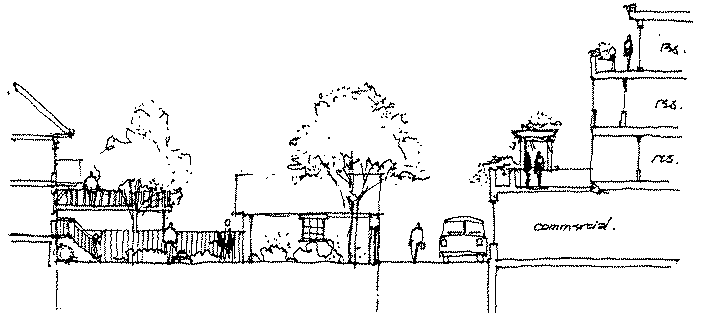
2.10 Safety and Security
Safety and a sense of security are key components of livability. New development, both residential and non-residential, must provide a secure environment. The principles of "crime prevention through environmental design" (CPTED) should be incorporated in all new development.
(a) Public, private and semi-private territories should be clearly defined. Public and semi-private spaces should be configured to maximize surveillance. Spaces which are neither clearly public or private tend to be unsupervised and unkept areas, and should be avoided;
(b) Separate lobbies and circulation (including elevators) should be provided for non-residential and residential uses. Lobbies should be visible from the street and main entrances to buildings should front the street;
(c) Personal safety and security should be integral to the design of parking facilities. Underground residential parking, including pedestrian access routes from parking into the building, should be secure and separate from commercial parking;. When open parking occurs, the area should be secured from public access in non-business hours (see Section 4.9 Off-street Parking and Loading).
(d) Both residential and non-residential uses should maximize opportunities for surveillance of sidewalks, entries, circulation routes, semi-private areas, children's play areas and parking entrances. Blind corners and recessed entries should be avoided. Visibility into stairwells and halls is desirable. Laundry facilities, amenity rooms, and storage rooms should be grouped together and visible for surveillance;
(e) Residential lighting should ensure good visibility of access routes and landscaped areas, without excessive lighting levels, glare or overspill to neighbours;
(f) Landscaping and screening design should not provide opportunities for intruders to hide; and
(g) Access routes from the building to residential garbage facilities should be separate and secure from those to non-residential garbage facilities.
Territory Definition
2.11 Access and Circulation
2.11.1 Pedestrian Access
(a) Primary pedestrian access to all uses should be from the street at street level;
(b) Residential entries should be separate and distinct from non-residential entries and lobbies;
(c) Internal public circulation systems such as shopping malls, are discouraged;
(d) Elevators should be provided on sites with frontage exceeding 15.0 m, where the vertical distance from parking to the highest unit entry exceeds three storeys; and
(e) Corridors should be adequately sized for moving furniture and should not be overly long (no more than 23.0 m in any one direction) or circuitous.2.11.2 Vehicular Access
To ensure an active pedestrian environment, vehicular and service functions should not conflict with street frontage and pedestrian activity.
(a) Vehicular access to underground parking, loading and service areas should be provided from the lane rather than the street. In the Cedar Cottage Area,
Tthe exception is Porter Street, which is the equivalent of a lane for some sites fronting on Commercial Street;
(b) Negative impacts of vehicular entrance parking ramps and service areas should be minimized through proper treatment such as enclosure, screening, high quality finishes, sensitive lighting, and landscaping; and
(c) Where street access is considered, as noted in (a), vehicular entrances should be designed integrally with the building. Any vehicular entrance from the street should minimize interruption to pedestrian movement and building frontage on the street. In particular, large or long access ramps located directly off the street should be avoided.3 Uses
3.1 Residential Use (Dwelling)
(a) In the Cedar Cottage and Hudson Street Areas, residential use is appropriate on any site; and
(b) In the MC-1 zoned part of East Hastings (Clark to Semlin) Area, residential use is appropriate on any site. (Residential uses are inappropriate on the north side of East Hastings Street because it is adjacent to a long term heavy impact industrial area. Therefore, residential use is not included in the MC-2 zoning.)Not withstanding the above,
Rresidential uses are discouraged where incompatible with other uses in the same project or uses nearby, as indicated in the Residential Compatibility Matrix (Appendix A). (It should be noted that combining residential with some industrial uses is not permitted by theBuilding By-law or requires special code equivalencies. Early discussion withPermits and Licences Departmentthe Chief Building Official is advised.)3.2 All Residential Buildings (Multiple Dwelling)
Generally, sSection 3.2 of the Districts Schedule requires non-residential uses at grade. However, buildings with residential uses at grade may be considered in the following locations in the Cedar Cottage, Hudson Street and East Hastings (Clark to Semlin) MC-1 Areas.along the north side of Stainsbury Avenue between Porter Street and the Victoria Diversion.(a) In the Cedar Cottage Area, buildings with residential uses at grade may be considered along the north side of Stainsbury Avenue between Porter Street and the Victoria Diversion;
(b) In the Hudson Street Area, buildings with residential uses at grade may be considered throughout the area; and
(c) In the East Hastings (Clark to Semlin) MC-1 District Area, residential uses at grade may be considered along the Pender Street frontage.3.3 Uses at Grade
As noted above, non-residential uses are generally required at grade. These may be retail uses, as well as service, office and industrial uses, as long as pedestrian interest is provided (as suggested in section 5 Architectural Components).
3.4 All Other Conditional Uses
Generally, a
All other conditional uses may be considered anywhere in the Cedar CottageMC-1district, Hudson Street and East Hastings (Clark to Semlin) MC-1 and MC-2 Areas subject to the guidelines in other Sections of this document,excepthowever:(a) Some u
Usesaremay be discouraged either in the same building or on an adjacent site when they are incompatible with residential uses,either in the same building or ,on an adjacent siteas indicated in the Residential Compatibility Matrix (Appendix A); and
(b) Institutional uses, including churches, may be considered as long as parking, circulation and access issues can be satisfactorily addressed.4 Guidelines Pertaining to the Regulations of the Zoning and Development By-law and the Parking By-law
4.2 Frontage
There is no maximum or minimum frontage for a development. However, in the Cedar Cottage Area, the design of development should maintain the traditional small scale and rhythm of Commercial Street, and extend it to the Victoria Diversion and Stainsbury Avenue. Similarly, in the Hudson Street Area, the scale of development should maintain the pattern that currently exists. In the East Hastings (Clark to Semlin) Area, current ownership patterns and the scale of development are such that development on larger lot assemblies will be more common. In addition, this area may see the continuation of relatively low scale, low density development. The design of development should consider the following principles in establishing and maintaining pedestrian scale and interest along the street.
(a) In the Cedar Cottage Area, b
Buildings should be designed with a rhythm of bays that relate to the traditional scale of buildings (e.g., a typical 20.1 m wide building has 4 bays). At ground level, the bays should be designed so that they can be infilled with different treatments, depending on the use; and
(b) In both the Cedar Cottage and Hudson Street Areas,Oon sites with larger frontages (e.g., more than 30.2 m),in addition to the rhythm of bays noted above,the development should be expressed as a number of smaller buildings. This should be done through a significant break in the massing.
(c) In the East Hastings (Clark to Semlin) Area, larger assemblies and the arterial location make larger, longer building design acceptable. However, facades should be designed toavoid monotony through variety the use of articulation, windows, vertical elements, textured surfaces, architectural detailing, graphics or colours.Cedar Cottage and Hudson Street Area
East Hastings (Clark to Semlin): On larger
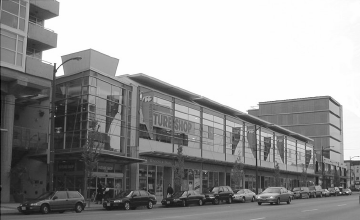
sites, architectural treatment can avoid
monotony.4.3 Height
(a) The maximum height of 12.2 m may be increased up to 13.8 m to allow for:
(i) non-combustible construction of the residential component; or
(ii) provision of roof design features beneficial to the character of the area; or
(iii) response to topography, where the slope is more than 1.5 m across the site; or
(iv) provision of raised residential entries, if desired.4.4 Front Yard and Setback
The current pattern in the Cedar Cottage, Hudson Street Area and the Pender Street frontage within the East Hastings (Clark to Semlin) A
area is for buildings to be built to the property line, without setbacks. Regulations generally call for new buildings to be placed at the front property line. However:(a) In the Cedar Cottage Area, Hudson Street Area and on the Pender Street frontage, m
Modest front setbacks may be considered where:
(i) it is desirable to inset store frontages, doors, etc.;
(ii) a pedestrian courtyard or other features benefiting pedestrian character are provided;
(iii) bay windows are to be located on upper storeys (to avoid street encroachment);
(iv) residential use is located at grade and space for steps or patio is desired; or
(v) needed to help new residential development adapt to existing industrial uses.(b) Setbacks should be configured and sized to achieve transition to neighbouring building faces.
Along Hastings Street, more diverse building forms on larger lots, with surface parking in some areas, is expected to continue. Buildings may be set back to mitigate the location along a major truck route and arterial. However, efforts should be made to site the buildings so as to define the street, anchor corners, and relate to neighbouring buildings.
(a) On larger sites with surface parking, buildings should be sited with the longest face of the building oriented towards the street.
(b) Building setbacks should provide a transition to those on the adjoining site. Encourage continuity between neighbouring development either by locating new buildings to join with existing buildings, or by locating buildings with one side at zero setback to allow a building on an adjoining site to abut the proposed building.
(c) On corner sites, buildings should be located at the corner.
(d) Open parking lots should have a landscaping strip along the street edges.
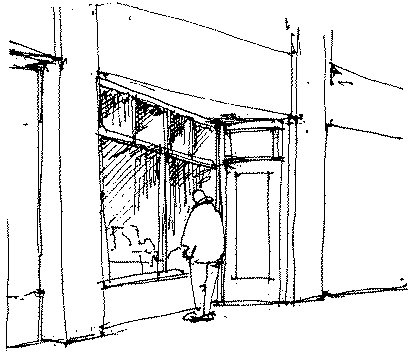
4.5 Side Yards and Setbacks
On corner sites, the building should be built to the property line of the flanking street or avenue, but with the same provisos as noted in Section 4.4 for the front yard and setback applying.
4.7 Floor Space Ratio
(a) Not all projects and sites will be able to achieve the maximum discretionary 2.5 FSR. (For example, while 1.5 FSR residential is easily accommodated on three levels above grade, the ground floor level is unlikely to accommodate a full 1.0 FSR of other use due to requirements for parking, loading and so forth.) Factors influencing the achievable density and use mix include:
(i) proportion of non-residential and residential use;
(ii) corner or mid-block site location;
(iii) site frontage;
(iv) mix of dwelling unit sizes;
(v) response to guidelines on height and front setbacks; and
(vi) ability to provide required parking.(b) Section 5.2 of the Districts Schedule permits a relaxation of the residential FSR from 1.5 to 1.8. The 0.3 FSR should be used for additional residential space at grade, in the rear, provided the additional space is non-market and/or guaranteed rental housing.
4.9 Off-Street Parking and Loading
Parking and loading are essential service functions. However, they can seriously detract from residential livability unless careful design is used to screen them from residential uses in and near the development. The type of parking provided, whether surface or underground, may be dependent on the use and intensity of the development. Lower intensity development on larger sites or developments such as auto-oriented sales or service generally has surface parking. More intensive development such as mixed use residential generally provides parking underground. Both types of parking may occur, particularly in the Hastings Street (Clark to Semlin) Area.
(a) For most types of development, p
Parking should generally be located underground; exceptions may be considered for small sites, or where a limited number of at-grade stalls are provided for visitor parking;
(b) Where it is notpossiblereasonable to place all parking underground, given the type of development, any at-grade stalls should be located at the rear of the site and not within the front setback, or side setback on a flanking street. Roof top parking will not be considered in the Cedar Cottage and Hudson Street Areas. However, where topography permits, it may be considered in the Hastings (Clark to Semlin) Area as long as impacts can be mitigated. Where an open parking lot occurs, the area should be secured from public access in non-business hours [see section 2.10 (c)];
(c) For slabs over parking/loading areas, under-slab height at the point of parking access should be limited to 3.7 m maximum. Where structural or mechanical elements project below a slab over parking/loading area, requiring an increase in the 3.7 m maximum height at the lane, these elements should be screened from view;
(d) Parking at or above grade should be screened effectively from view of pedestrians and neighbours. Depending on the specific site, this should include solid roofs to avoid noise and visual impacts to dwelling units above, appropriate lighting, architecturally treated surfaces, screen walls, doors, and landscaping along the lane to reduce impacts on adjacent dwelling units;
(e) Parking for non-residential uses and residential visitors should be separate from residential parking, which should be secured by garage doors; and
(f) Convenient loading of furniture to residential units should be facilitated by the design of loading areas and access routes.4.10 Horizontal Angle of Daylight
(a) Where the horizontal angle of daylight is proposed to be decreased as permitted in section 5.3 of the MC-1 District Schedule, the distance of unobstructed view should not normally be less than 12.0 m for living rooms and 6.0 m for bedrooms and dens; and
(b) In situations where the horizontal angle of daylight is decreased to the minimum of 3.7 m, additional overshadowing of windows by overhead balconies or other projections should be avoided.5 Architectural Components
5.1 Roofs
(a) Where the prevailing scale of the street is consistent, and less than four storeys, t
The fourth floor should be designed to visually recede from the street, so that compatibility with the prevailing scale of the street is maintained. Examples of how to achieve this are:
(i) emphasis on third floor cornice;
(ii) change to lighter, more transparent material or expression; and/or
(iii) setback of fourth floor facade from main facade plane.(b) Roofs should be designed to be attractive as seen from above through landscaping, elements such as gazebos and trellises, and choice of materials and colour. Elements such as roof gardens and roof decks should be provided to increase usability of roofs whenever issues of overview and privacy can be adequately addressed; and
(c) Elevator penthouses, mechanical rooms, equipment and vents should be integrated with the architectural treatment of the roof.

5.2 Windows and Skylights
Windows at grade are important to enhance pedestrian interest, particularly since retail uses are not required at grade in this area.
(a) For retail, service or office use:
(i) maximize transparency through use of high transom, low sill window designs, as well as openable windows where appropriate. For service and office uses, design should allow for retail use in the future.
(b) For industrial use:
(i) provide windows for viewing to industrial processes where possible; and
(ii) where windows cannot be used, use other means to add visual interest such as expressed vertical elements, vines, murals, and detailing. Avoid long stretches of blank wall.(c) For residential use, where located at grade:
(i) design windows to contribute to pedestrian interest and street surveillance, as well as needed privacy and territorial definition.
Details add interest where transparency
cannot
Maximize transparency for pedestrian
interest5.3 Entrances, Stairs and Porches
(a) When residential uses are located at grade, individual unit entrances at grade are an option but not a requirement. If provided, they can help achieve unit identity and pedestrian interest, but also need to be designed for privacy and territorial identity; and
(b) Shared residential entrances to buildings should also be designed as attractive, visible features.5.4 Balconies
(a) Balconies should be designed to maximize light into the unit.
5.5 Exterior Walls and Finishing
(a) The lower levels of development should be carefully designed to be related to pedestrian scale, and enhance the close-up view of the pedestrian. The use of high quality materials and more intensive detailing that contribute to pedestrian interest is encouraged;
(b) Vines or other landscaping should be used to soften blank building walls throughout the area;
(c) When party walls are likely to remain exposed for the foreseeable future, as a result of adjacent low-scale development, they should be carefully designed emphasizing quality materials, textures, articulation, colour and/or landscaped with climbing or hanging plants; and
(d) Walls abutting the lane should be carefully designed to be attractive to neighbouring developments and passers by through articulation, the use of quality materials, and landscaping.
Vine planting adds interest
5.6 Awnings and Canopies
Section 2.7 describes where weather protection should be located. In terms of appearance, using a uniform canopy or awning design across the entire building is inappropriate to the diversity to be maintained.
(a) Design architecturally integrated, high quality awnings and canopies, but ensure some variety in form, and/or the ability for tenants to vary them to suit themselves.
(b) Ensure that awnings and canopies are deep enough and close enough to the ground to provide shelter.Architecturally integrated, high quality
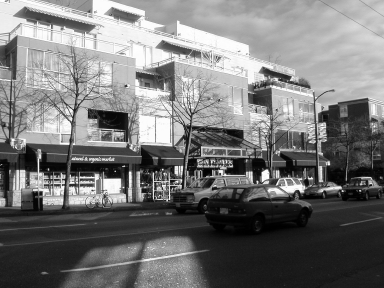
awnings and canopies
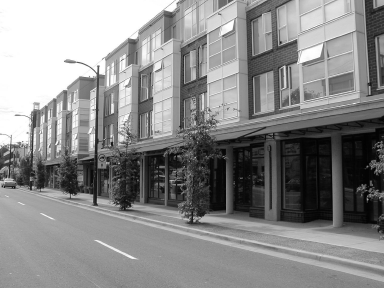
5.7 Lights
(a) Individual projects should contribute to improved lighting levels for pedestrians
on Commercial Street,by providing low intensity lighting on the building face; and
(b) Buildings, open spaces and parking areas should have lighting located and designed to ensure that all areas are well lit. However,sSite lighting should be sensitive to the residential uses in the building and neighbouring area. Visible, glaring light sources can be avoided through using down-lights mounted on lower walls or on landscaped elements, or free-standing pole lights with shaded fixtures.
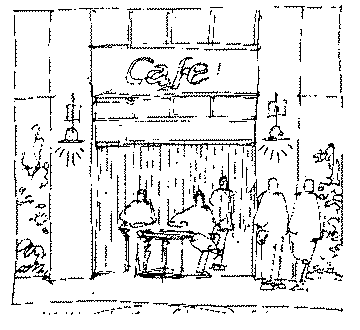
7 Open Space7.1 Public Open Space
(a) In the Cedar Cottage Area, s
Small public mini-parks are anticipated as part of intersection improvements for the corners of Commercial Street at 18th, 20th and 22nd Avenues. In the Hudson Street Area, properties on the northern portion of Selkirk and Osler Street and fronting 72nd Street have been acquired by the Vancouver Park Board and will be developed as a future park. Developments abutting these locations should respond through locating windows and/or doors to advantage, provision of outdoor seating, etc.
Cafes on the park, parkettes and elsewhere
7.2 Semi-Private Open Space
(a) "Active" or "social" semi-private open space is desirable, and should be provided for residents wherever possible. It could be located above the commercial level or on the rooftop but should maximize sun exposure, and be protected from noise and overlook from neighbouring buildings. Privacy of adjacent units and properties, view blockage and noise impact on units and properties below should be addressed;
(b) In courtyard projects, courtyards typically serve a combination of functions, such as circulation, as a buffer between units, and as a source of daylight and air to courtyard-facing rooms. Owing to their often forced linearity and requirements of protecting privacy while providing access, this type of courtyard is rarely suitable as social semi-private open space; and
(c) Large development parcels may have site area that could be publicly used as open space, on a voluntary basis. Where this occurs, consideration should be given to design for usability, attractiveness, security/safety, and maintenance.7.3 Private Open Space
(a) Private open space should be provided for each unit in the form of balconies, decks or patios with a minimum single horizontal dimension of 1.8 m and a minimum area of 4.5 m²;
(b) Private open space should be designed to capture sun and views where possible, as well as to avoid noise and to take account of visual privacy and security. Balcony enclosure to reduce noise may be appropriate in some cases; and
(c) To help create defined and usable private space at grade, a front garden or low, raised porch should be considered.8 Landscaping
8.1 Streetscape
A streetscape concept plan for the MC-1 and MC-2 areas may be adopted in the future. In the meantime, street trees should be provided on all streets not currently having them, or where their spacing is inconsistent. Park Board and Engineering staff will specify species, spacing, and location.
8.2 Site Landscape
(a) Existing trees and significant landscape features should be retained where possible;
(b) Landscaping close to the street should be used to soften the built form, and contribute to pedestrian interest. Layering of plant material, including vines on vertical surfaces, can have a rich appearance in minimal space;
(c) Landscaping should be provided on amenity roof decks and for screening to provide privacy where required;
(d) Landscaping should be considered adjacent to rear lanes, provided that branches are kept clear of the lane right-of-way, and provided that security is not unduly compromised;
(e) Landscaping should be used to help mitigate impacts between residential and industrial uses;
(f) Landscape design on other parts of the site should relate to anticipated activities.; and
(g) Along Hastings Street where development with surface parking may occur, surface parking lots should be landscaped to reduce the visual impact. Consider introducing distinct paving surfaces, geometric patterns, trees, landscaped planters and trellises to improve the image of the parking area.
Planting on roof deck and over
underground garage entrance9 Utilities, Sanitation, and Public Services
9.2 Underground Wiring
In order to improve the visual environment for residents, developments on larger sites (45.0 m frontage or wider) should investigate with the City Engineer the feasibility of using underground wiring for electric, telephone and cable services, including the removal or partial removal or existing overhead plant.
9.3 Garbage and Recycling
Garbage and recycling are essential services. They can seriously detract from residential livability unless careful design is used to screen them from residential uses in and near the development.
(a) Garbage and recycling facilities should be located adjacent to the lane. They should be fully enclosed by a roof and sides, and screened from the lane.
Appendix A
Residential Compatibility Matrix
This chart indicates the compatibility of uses with residential development. It does not indicate the acceptability of potential proposals, as other factors such as land use objectives, Noise By-law, Parking By-law, and servicing requirements may take precedence.
Compatibility Rating Definitions:
Compatible - Suitable for mixed-use building with a residential component.
Incompatible - Unsuitable for a mixed-use building with a residential component.
Noxious - Unsuitable to be within 7.6 m of a mixed-use building with a residential component and therefore residential applications are unsuitable within 7.6 m of any existing noxious uses.
* Residential compatibility can be improved one rating (i.e., from noxious to incompatible or from incompatible to compatible) depending on specific use, scale, and design of either the proposed use or the existing adjacent uses.
1 While the residential units associated with Artist Studio - Class B are compatible uses, other residential uses are unsuitable within the same building.
MC-1 AND MC-2 DISTRICTS | ||
USE |
Outright |
Conditional |
CULTURAL AND RECREATIONAL |
||
Artist Studio - Class A |
Compatible | |
Artist Studio - Class B1 |
Incompatible | |
Billiard Hall |
Incompatible | |
Bowling Alley |
Noxious | |
Club |
Incompatible* | |
Community Centre or Neighbourhood House |
Incompatible | |
Fitness Centre |
Compatible | |
Hall |
Incompatible | |
Library |
Compatible |
|
Museum or Archives |
Compatible |
|
Park or Playground |
Compatible | |
Rink |
Incompatible | |
Swimming Pool |
Incompatible | |
Theatre |
Incompatible | |
Zoo or Botanical Garden |
Incompatible | |
INSTITUTIONAL |
||
Ambulance Station |
Noxious | |
Child Day Care Facility |
Compatible | |
Church |
Incompatible | |
Detoxification Centre |
Noxious | |
Public Authority Use |
Incompatible | |
School - Elementary or Secondary |
Incompatible* | |
School - University or College |
Incompatible* | |
Social Service Centre |
Incompatible* | |
Special Needs Residential Facility - (All) |
Incompatible* | |
MANUFACTURING |
||
Bakery Products Manufacturing |
Incompatible* |
|
Chemicals or Chemical Products, Manufacturing - Class B |
Noxious* |
|
Clothing Manufacturing |
Incompatible* |
|
Dairy Products Manufacturing |
Incompatible* |
|
Electrical Products or Appliances Manufacturing |
Incompatible |
|
Food or Beverage Products Manufacturing - Class B |
Incompatible* |
|
Food or Beverage Products Manufacturing - Class A |
Noxious | |
Furniture or Fixtures Manufacturing |
Incompatible |
|
Ice Manufacturing |
Incompatible |
|
Jewellery Manufacturing |
Incompatible* |
|
Leather Products Manufacturing |
Incompatible* |
|
Metal Products Manufacturing - Class B |
Noxious | |
Miscellaneous Products Manufacturing - Class B |
Incompatible* |
|
Non-metallic Mineral Products Manufacturing - Class B |
Incompatible* |
|
Paper Products Manufacturing |
Noxious* |
|
Plastic Products Manufacturing |
Incompatible* |
|
Printing or Publishing |
Incompatible* |
|
Shoes or Boots Manufacturing |
Incompatible* |
|
Software Manufacturing |
Incompatible* |
|
Textiles or Knit Goods Manufacturing |
Incompatible* | |
Tobacco Products Manufacturing |
Incompatible* |
|
Wood Products Manufacturing - Class B |
Incompatible* | |
OFFICE |
||
Financial Institution |
Compatible |
|
General Office |
Compatible |
|
Health Care Office |
Compatible |
|
Health Enhancement Centre |
Compatible | |
PARKING |
||
Parking Area |
Compatible | |
RETAIL |
||
Furniture and Appliance Store |
Compatible | |
Gasoline Station - Full Serve |
Incompatible | |
Gasoline Station - Split Island |
Incompatible | |
Grocery or Drug Store |
Compatible |
|
Liquor Store |
Incompatible | |
Pawnshop |
Compatible | |
Retail Store |
Compatible |
|
Secondhand Store |
Compatible | |
Vehicle Dealer |
Compatible | |
SERVICE |
||
Animal Clinic |
Incompatible |
|
Auction Hall |
Incompatible | |
Barber Shop or Beauty Salon |
Compatible |
|
Bed and Breakfast Accommodation |
Compatible |
|
Catering Establishment |
Incompatible |
|
Funeral Home |
Incompatible | |
Laboratory |
Noxious* |
|
Laundromat or Dry Cleaning Establishment |
Incompatible* |
|
Laundry or Cleaning Plant |
Noxious |
|
Motor Vehicle Repair Shop |
Noxious |
|
Motor Vehicle Wash |
Noxious |
|
Neighbourhood Public House |
Noxious | |
Photofinishing or Photography Laboratory |
Compatible |
|
Photofinishing or Photography Studio |
Compatible |
|
Print Shop |
Compatible |
|
Production or Rehearsal Studio |
Incompatible |
|
Repair Shop - Class A |
Noxious |
|
Repair Shop - Class B |
Incompatible |
|
Restaurant - Class 1 |
Incompatible* |
|
School - Arts or Self-Improvement |
Compatible |
|
School - Business |
Compatible |
|
School - Vocational or Trade |
Incompatible |
|
Work Shop |
Noxious* |
|
TRANSPORTATION AND STORAGE |
||
Cold Storage |
Noxious* | |
Storage Warehouse |
Incompatible* | |
Taxicab or Limousine Station |
Noxious* | |
Works Yard |
Noxious* | |
UTILITY AND COMMUNICATION |
||
Public Utility |
Incompatible | |
Radiocommunication Station |
Incompatible | |
Recycling Depot |
Noxious* | |
WHOLESALE |
||
Lumber and Building Materials Establishment |
Incompatible | |
Wholesaling - Class A |
Incompatible* | |
Wholesaling - Class B |
Incompatible* | |
![[City Homepage]](/graphics/footnava.gif)
|
![[Get In Touch]](/graphics/footnavb.gif)
|

|

|

|
(c) 1998 City of Vancouver